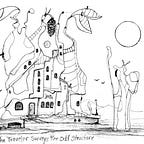How Strong Towns Principles Relate to Sioux Falls — Complex vs Complicated
- based on “Strong Towns — A Bottom-Up Revolution To Rebuild American Prosperity” by Charles L. Marohn, Jr.
“When humans imagine cities as complicated machines and not complex human habitat, they fail to grasp what is really happening. They misdiagnose problems and opportunities as being a byproduct of one or two related variables, instead of one manifestation of an interrelated, complex system.” — Chuck Marohn
Understanding the difference between complex systems and merely complicated systems is key to understanding how traditional city building differs from our current city model of urban sprawl. Complex systems are often compared to living systems like a forest. If a tree falls in the forest, the forest doesn’t stop working. The fallen trunk decomposes and provides nutrients for birds, animals, fungus and mushrooms. Smaller trees flourish in the open space where the tree used to stand. Many interactions occur that may cause the forest to be stronger than it was before. This is a complex system that is capable of adapting to stress.
A complicated system, in contrast, is something like a mechanical watch that has a lot of moving parts. Springs and gears work together to show you the time. You know that once the minute hand makes one revolution around the watch face the hour hand will move to the next hour marking. It is complicated but predictable. But, unlike a complex system, a watch can’t adapt to stress. If a gear breaks, the watch just stops working.
In terms of city building, Downtown Sioux Falls is a complex system. It grew organically using buildings with flexible designs. The same 20’ x 80’ commercial space could be a clothing store, restaurant, bar, boutique, jewelry store, art gallery or tattoo parlor. The second floor could have commercial offices or apartments. People in the apartments and offices provided a built-in customer base for the businesses on the first floor. The presence of people in the area attracted more people. An entrepreneur who saw this activity and wanted to start a business could rent a space and give it a go. Some succeeded but many failed. In the process, people learned what worked and what didn’t. There was no need to tear everything down every time a business moved out. Someone else would repaint, put up a sign and start a new business. The downtown area adapted to stress, evolved and has survived for over 100 years.
Now let’s look at an area of the city that is complicated but lacks the human interactions that would make it a complex system. A strip mall was built along W. 10th Street with limited access even by car. There are some residential areas nearby but it is unlikely anyone will want to walk there. It has water, sewer, power and adequate parking. It meets code — all the boxes are checked. It has been vacant for years and is just waiting to be torn down and redeveloped. It is complicated but not complex enough to adapt and survive. It was built as a finished product rather than being built as needs warranted. “If you build it they will come” — except they didn’t.
Marohn makes the point that when we think of cities as just complicated we make the mistake of thinking all we have to do is check the boxes and throw resources at a problem to solve it. For instance, if we have a crime problem the “just complicated” solution is to hire more officers. The “complex” solution would look at the design of neighborhoods. Do buildings have windows and entrances facing the street so people can see who is coming and going in the neighborhood. Does the streetscape encourage people to hang out and reduce the opportunity for crime. These concepts are the type of thing we learned through a millenia of building cities using trial and error. Now we need to relearn those ideas and apply them to our city.
Want to check out the book? Buy it here.
